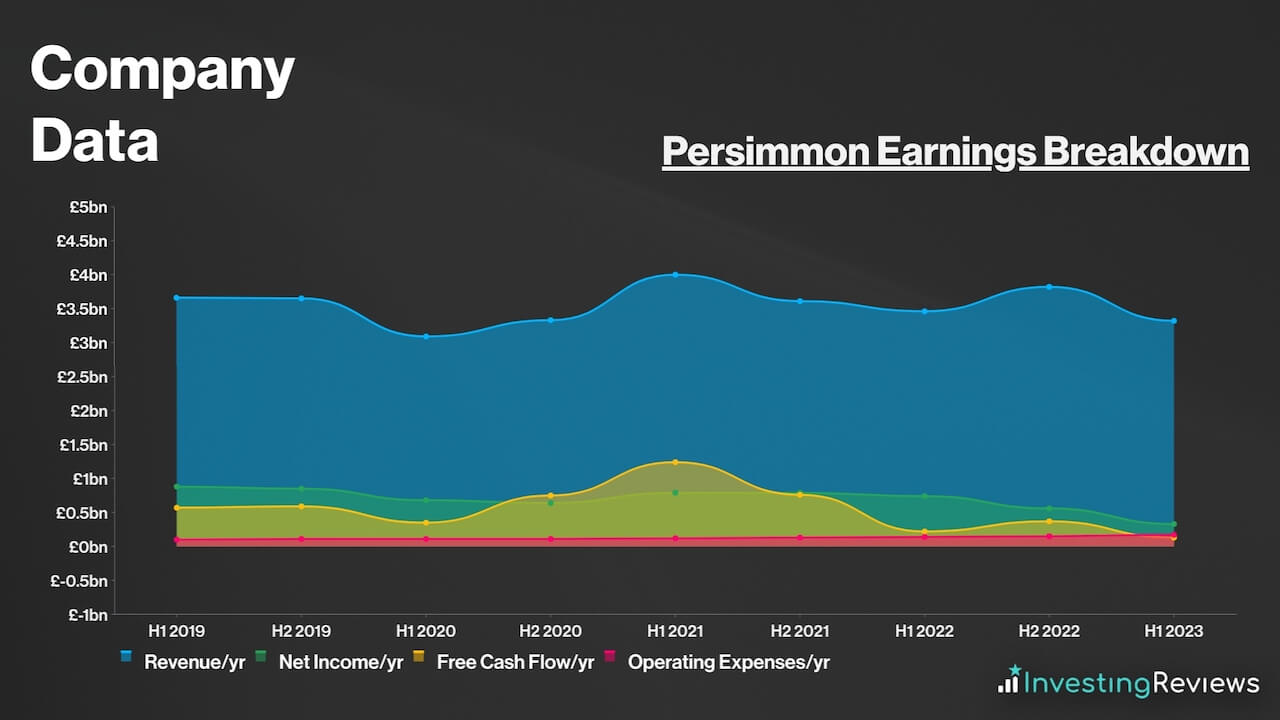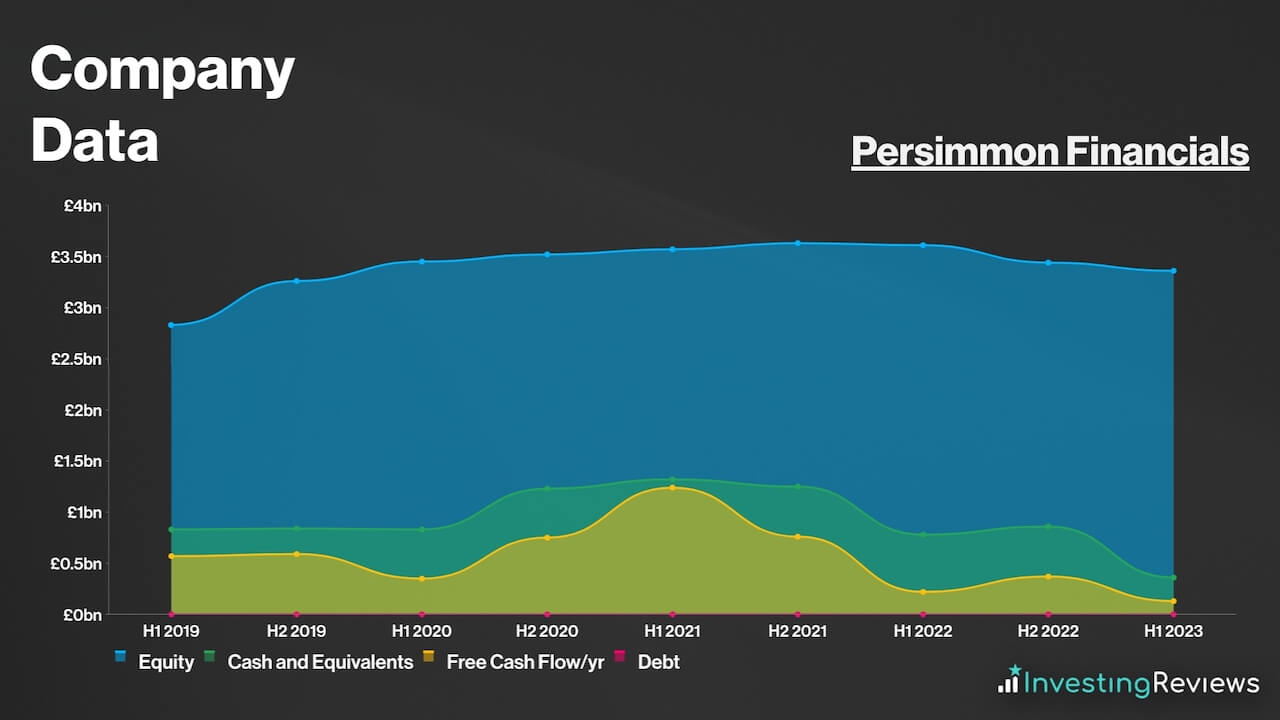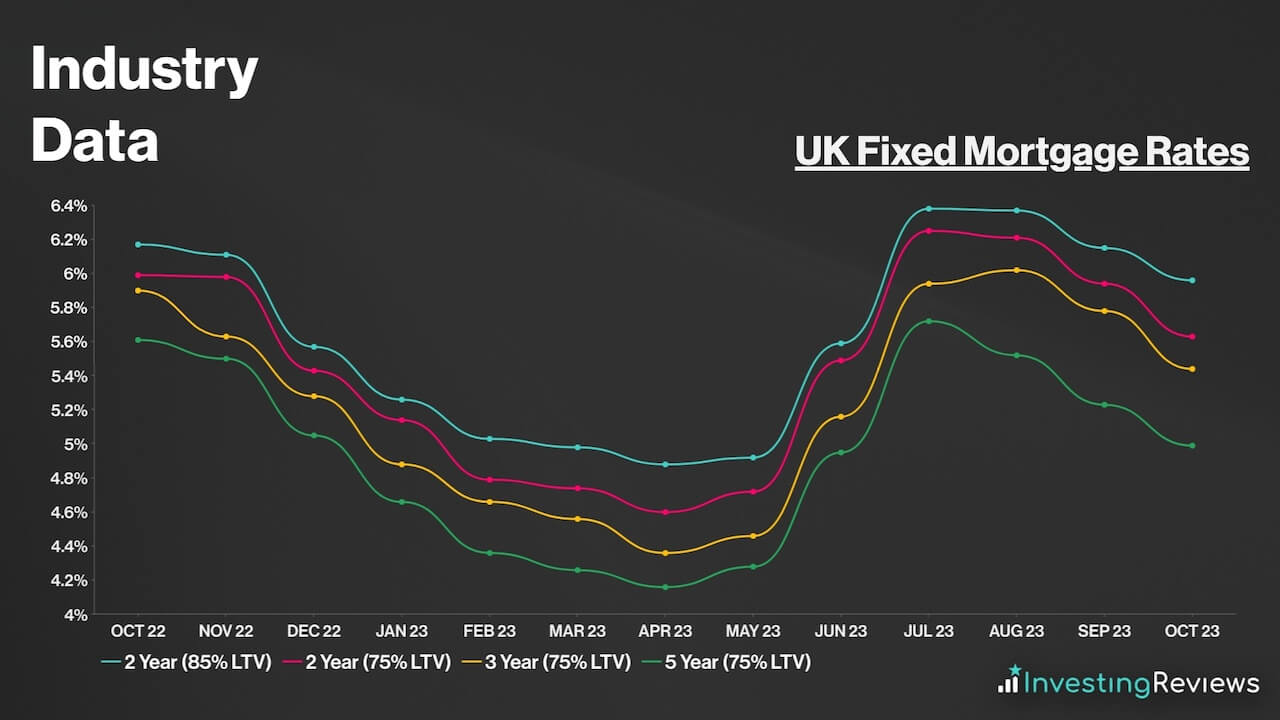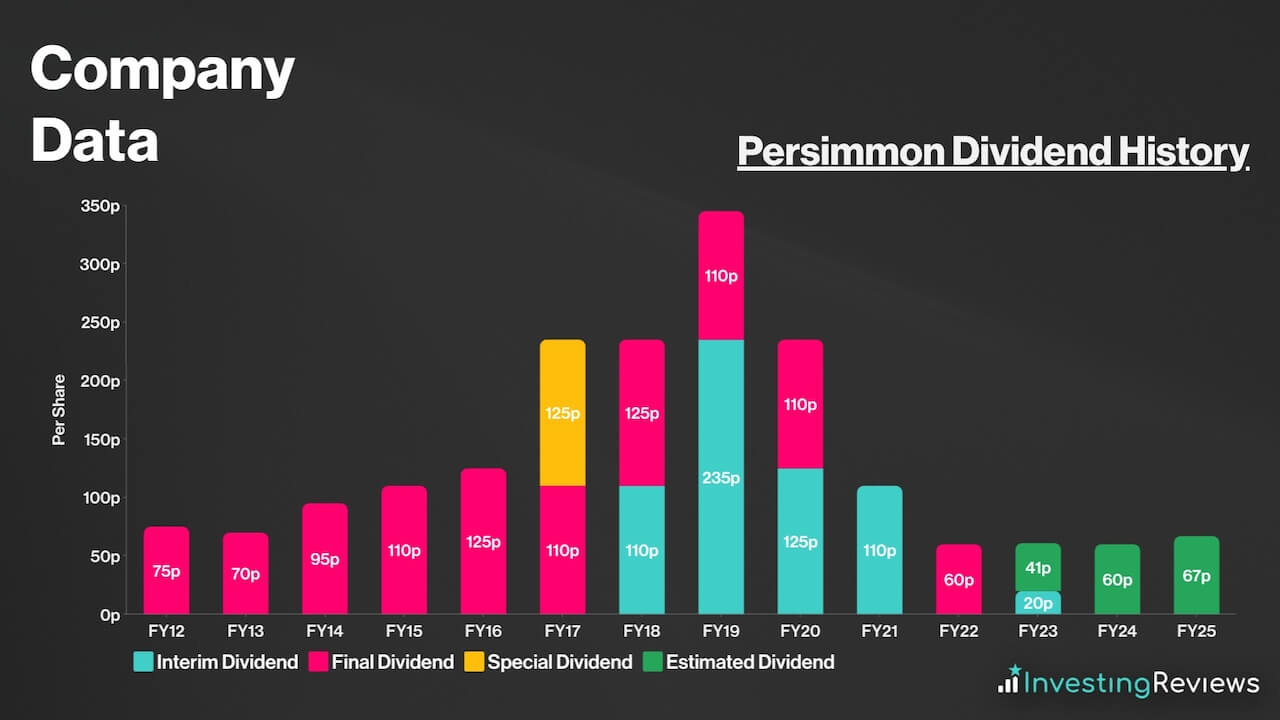
My Persimmon share price forecast includes a 360-degree examination to determine whether investors should consider this housebuilder and build the stock into their portfolios.
This stock analysis report goes into detail on Persimmon’s financial position, competitive strengths, industry outlook, valuation metrics, and analysts’ predictions to uncover whether Persimmon shares actually present a golden long-term opportunity.
Read On: To find the Persimmon share price forecast and my price target.
- Persimmon Share Price (LON:PSN)
- Persimmon Background
- Persimmon Business Model
- Persimmon Earnings Breakdown
- Persimmon Financials
- Persimmon Competitive Advantage
- Persimmon Shortcomings
- What is the Dividend Forecast for Persimmon Shares?
- Are Persimmon Shares Cheap?
- What is the Profit Forecast for Persimmon Shares?
- What is the Persimmon Share Price Forecast?
- What is the Price Target for Persimmon Shares?
- Are Persimmon Shares a Buy, Sell, or Hold?
Persimmon Background
Persimmon is one of the largest housebuilders in the UK by houses built with a sizeable market share. It’s known to be one of the big five developers in the country. As a whole, Persimmon builds properties across the UK under the brands of Charles Church, Westbury Partnerships, and Persimmon itself.
Altogether, it builds approximately 10,000 properties per year on average. It builds a wide variety of homes, ranging from flats to six-bedroom houses.
Persimmon shares trade on the London Stock Exchange and are constituents of the FTSE 250.
Find Out: How easy it is to buy Persimmon shares in 6 simple steps.
Persimmon Business Model
As a conglomerate, Persimmon essentially makes most, if not all of its money from selling new homes and land. The bulk of its sales stems from new homes where it acquires land, develops it through building properties, and then sells those properties at a premium. On top of that, Persimmon also generates a tiny portion of revenue from land sales and property exchanges.
On the geographical front, the company predominantly earns its money from building houses all across the UK. Most of its homes are built in England, but it’s got a rather even exposure throughout the country, though historical trends would indicate that the company tends to build more properties in the northern regions, by a ratio of approximately 60:40.

Persimmon Earnings Breakdown
Persimmon operates a housebuilding business for the most part, and earns its profits from buying land, developing properties, and then selling them to buyers to turn a profit.
Due to the large complexities and paperwork surrounding land acquisition and house building, Persimmon’s economic moat is rather deep. This allows it to operate with reasonably high margins, as homes have rather inelastic demand — hence why Persimmon has healthy profit margins (>10%).

Persimmon Financials
On the face of it, Persimmon’s balance sheet is flawless, as its current assets trump its current liabilities by £3.27bn. This is considered to be a norm in the housebuilding industry, especially for giant builders as they require significant cushions to absorb the impact of a potential crash in house prices.

With virtually no debt, the FTSE 250 stalwart should have sufficient liquidity to continue operating in the coming years, as long as it continues to generate cash at these levels. It’s also worth noting that Persimmon has £700m worth of undrawn committed facilities. This means that it has the option to inject more liquidity into the business if it needs to.
Persimmon Competitive Advantage
Having an economic moat (competitive advantage) over competitors is crucial in saturated industries such as housebuilding, where profit margins are competitive, with medium barriers to entry.
Nonetheless, Persimmon’s main competitive advantage is its price proposition. Given that the York-based developer builds a large volume of houses, it can afford to charge cheaper prices due to economies of scale. As a matter of fact, Persimmon boasts the cheapest average house price amongst its big five peers, and by quite some margin too.
| Housebuilder | Average Selling Price |
|---|---|
| Taylor Wimpey | £320,200 |
| Barratt | £319,600 |
| Persimmon | £276,700 |
| Berkeley | £608,000 |
| Bellway | £310,300 |
Data source: FactSet
In addition to its competitive advantages, Persimmon also ranks highly for customer satisfaction, with a 5-star score, based on the National New Homes Survey, run by the Home Builders Federation.
Aside from that, it’s also got a massive land bank. Its short-term land bank (ready for development in the near future) currently stands c.85k plots, while its strategic land pipeline (Permission to build in future) stands at c.13.1k acres.
Assuming an average output of c.13k houses a year, this gives the housebuilder the capacity to build more houses on ready-to-build land for the next six years or so, with the potential of another seven years or so thereafter.
To top it off, Persimmon has got a perfect set of financials, and is one of the better-run FTSE 250 companies. This allows it to pay lucrative dividend yields, which is why it’s one of the FTSE’s most favourable dividend stocks amongst passive income investors.
But perhaps most lucratively, the UK housing market is notorious for its growing property values due to the huge discrepancy between supply and demand. As such, this presents an opportunity for housebuilders like Persimmon to capitalise on. In fact, the developer plans to scale its builds over time while vertically integrating its supply chain. This should grow revenue and profits meaningfully in the long term.
Persimmon Shortcomings
Despite being such a giant in the housebuilding space, Persimmon also has its fair share of weaknesses. This could put investors off when buying Persimmon shares.
Most prominently, because Persimmon lacks diversification in its revenue stream, its top and bottom lines are susceptible to shocks in the housing market, as has been the case over the past year.

Although average house prices have held up relatively better than what many analysts were forecasting, mortgage rates have still seen a substantial rise over the past year. Consequently, this has seen metrics such as sales rates, cancellations, and forward bookings decline on an annualised basis.

Additionally, Persimmon’s relatively diversified portfolio throughout the UK is a double-edged sword and makes it extremely vulnerable to a market crash. Some would argue that diversification is key, but it also prevents the FTSE 250 constituent from hedging against the risks of a steeper fall in house prices in a specific region.
Moreover, it’s worth noting that the corporation is vulnerable to supply chain shocks, and this was evident in 2022. Russia’s invasion of Ukraine drove up the prices of several building materials, such as cement and wood. As a consequence, its heavy reliance on outsourcing supplies ramped up build cost inflation last year, and was only offset by strong house prices.
Adding to that, the builder has to contend with higher costs from increasing environmental regulations from the government. For instance, developers are now strongly encouraged to abide by new building regulations that set minimum standards for newer, energy-efficient homes. This means that builders will have to install more efficient heating systems such as heat pumps which cost more.
Furthermore, the end of the government-led Help to Buy scheme has seen short-term completions dissipate, as Persimmon no longer enjoys the tailwinds from the programme as Help to Buy completions made up 21% of Persimmon’s total completions in 2022.
Then there’s cladding remuneration. This was caused by the Grenfell controversy which sparked a debate surrounding the replacement of unsafe cladding on older buildings, with housebuilders footing the bill. Even though Persimmon has responsibly pledged its full support for this initiative, it’s also taken on impairment charges as a result, thus impacting profits.
Persimmon pays a dividend and has been paying dividends as far back as 1992; even through the great financial crisis. This makes Persimmon a dividend aristocrat given its impressive track record of shareholder payments.
For that reason, Persimmon shares are known for their ‘safety’, and are a favourite among dividend investors seeking passive income. The stock is even more popular amongst investors over the past few years due to its incredible double-digit yields.
Nevertheless, the stock’s payouts have tumbled recently as a weakening housing market has seen property prices fall. In line with this, the lack of a Help to Buy tailwind has seen completions fall, and with that, profits. Therefore, management has reduced its dividend for the foreseeable future to protect its balance sheet despite a strong dividend cover of 4.1x.
Persimmon is expecting to continue paying a dividend for the foreseeable future. Currently, analysts are forecasting dividends to drop meaningfully in FY23 and remain stagnant in FY24.

Persimmon shares are currently trading at a premium when compared to their industry competitors. Their P/E and forward P/E ratios are in line with the FTSE 100‘s average too. But considering that their P/S ratio sit around 1, this could indicate tremendous growth potential from its sales.
Among the 18 qualified analysts covering Persimmon shares, the consensus is for Persimmon to see a drop in its top and bottom lines this year as demand for housing takes a backseat due to high mortgage rates, before growing again in FY24.
| Metrics | FY22 (Reported) | FY23 | FY24 | FY25 |
|---|---|---|---|---|
| Revenue | £3.82bn | £2.49bn | £2.60bn | £2.89bn |
| Adjusted Basic EPS | 245.3p | 80.14p | 81.70p | 101.94p |
Data source: FactSet
Persimmon shares currently have an average Hold rating from several brokers. With an average price target of 1222p, analysts seem to agree that there’s limited upside potential for Persimmon shares in the next 12 months.
| Date | Brokerage | Rating | Price Target |
|---|---|---|---|
| 14/11/2023 | Davy | Buy | 1393p |
| 10/11/2023 | Morgan Stanley | Sell | 1131p |
| 10/11/2023 | Jefferies | Hold | 1181p |
| 10/11/2023 | RBC | Hold | 1300p |
| 9/11/2023 | Peel Hunt | Hold | 980p |
| 9/11/2023 | Berenberg | Hold | 1300p |
| 7/11/2023 | JPMorgan | Hold | 1030p |
| 7/11/2023 | Investec | Hold | 1200p |
| 7/11/2023 | Morningstar | Buy | 2300p |
| 31/10/2023 | Numis | Hold | 1185p |
| 27/10/2023 | Liberum | Buy | 1310p |
| 25/9/2023 | Goodbody | Buy | 1500p |
Data source: FactSet
My price target for Persimmon shares was last updated on 16th November 2023.
| Metrics | FY23 Simplified Assumptions (Underlying) | Comments |
|---|---|---|
| Total Completions | 9,550 Homes | In line with guidance given stronger momentum post-H1. |
| Average House Price | £258,500 | c.4% increase — from mix shift towards second-time buyers. |
| Completions Revenue | £2.49bn | |
| Part Exchange Revenue | £0.13bn | c.20% increase — lack of affordability to spur higher churn in exchanged homes. |
| Fibrenest Revenue | £0.01bn | Flat growth from fewer completions. |
| Revenue | £2.63bn | |
| Cost of Sales | £2.08bn | c.79% of revenue — increase on last year from elevated cost pressures. |
| Gross Profit | £0.55bn | |
| Operating Expenses | £179m | c.6.8% of revenue — in line with guidance. |
| Other Income | £10m | In line with long-term average. |
| Operating Profit | £381m | In line with guidance of c.14%. |
| Finance Income | £15m | Higher interest receivables from higher interest rates. |
| Finance Costs | £15m | Higher interest payables from loans and lease liabilities. |
| Profit Before Tax | £381m | |
| Taxation | £103m | Underlying Tax Rate of c.27%. |
| Profit for FY23 | £278m | |
| Weighted Average Number of Diluted Ordinary Shares | 321.6m | Assuming dilution at annualised rate between FY22 and FY23. |
| Underlying Diluted EPS | 86.44p | |
| Target Price | 1310p (BUY) | |
The downward trajectory of inflation has seen mortgage rates slide, with sub-4% rates and higher LTV products on the verge of coming back to market. As house prices attempt to find a bottom while demand remains red hot, Persimmon is in prime position to capitalise on this as affordability increases. After all, real wages are now trending above inflation which has reduced the gap between average wages and house prices.
Therefore, more upside potential in the medium to long term can be expected. Considering the affordability constraints in the higher rate environment, Persimmon’s unique selling proposition in having the cheapest houses on the market may be advantageous as customers trade down. Pair that with a projected higher margin base than its peers from its vertical integration efforts, and the investment case for Persimmon is a solid one.
Additionally, given the easing of cost pressures going into FY24 and the bottoming of its order book, I’m expecting a gradual recovery in sales as soon as spring 2024. This should encourage margins, profits, as well as dividends to recover meaningfully going into FY25 and beyond. Hence, I rate Persimmon shares a Buy, as a trough may have been reached.
John Choong, Senior Equity Research Analyst
Please note: John Choong has positions in Persimmon. These stock analysis reports are not personal recommendations or advice and should never be treated as such.
The value of your investments (and any income from them) can go down as well as up and you may not get back the full amount you invested. Past performance is not a reliable indicator of future performance. Investments should be considered over the longer term and should fit in with your overall attitude to risk and financial circumstances.
